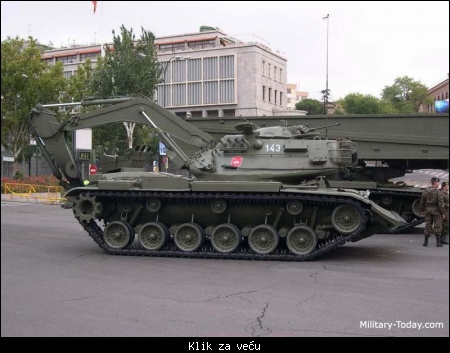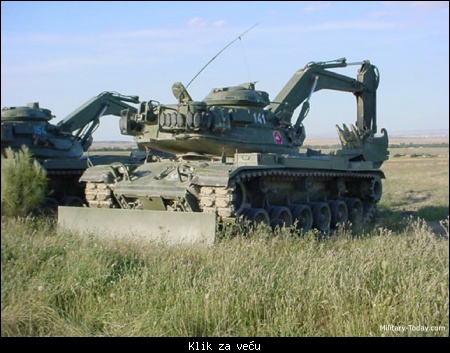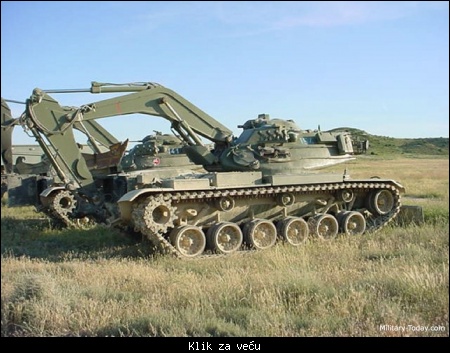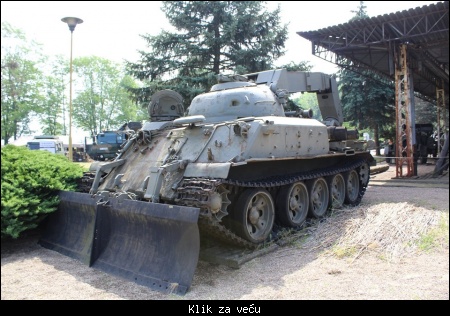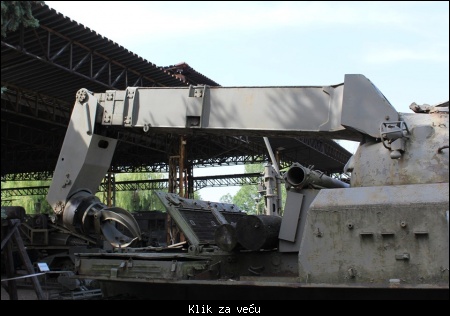|
Poslao: 22 Jun 2019 17:47
|
offline
- A.R.Chafee.Jr.

- Legendarni građanin

- Pridružio: 27 Avg 2018
- Poruke: 10919
|
Vozače M9 ACE su po kraju Pustnjiske oluje,nazvali usamljeni, nenaouržani i neustrašivi. Od tada se vuče predlog, da mu se doda kupolica za strelca sa teškim mitraljezom ili tako nešto.
|
|
|
|
|
Registruj se da bi učestvovao u diskusiji. Registrovanim korisnicima se NE prikazuju reklame unutar poruka.
|
|
|
Poslao: 22 Jun 2019 18:57
|
offline
- voja64

- Stručni saradnik foruma

- Pridružio: 10 Okt 2012
- Poruke: 25481
|
Za kupolicu i dodatno naoružanje se slažem samo nič ne vem dali bi vozač uz sve svoje rabote stizao i da puca ?
Nego po mnogo čemu u ovu familiju se tura i naslednik i poslednji iz loze BATova
BAT-2
Armored tracklayer

The BAT-2 armored tracklayer is a versatile engineering vehicle designed to fulfill many roles
Crew 2 + 8 men
Dimensions and weight
Weight 39.7 t
Length 9.64 m
Width 4.2 m
Height 3.69 m
Performance
Track laying speed (ordinary terrain) up to 6.8 km/h
Track laying speed (snow) 8.15 km/h
Track laying speed (trees) 2.3 km/h
Earth working capacity 200 - 250 m³/h
Crane capacity 2 t
Winch capacity 25 t
Mobility
Engine V-64-4 diesel
Engine power 700 hp
Maximum road speed 60 km/h
Range 500 km
Maneuverability
Gradient 60%
Side slope 40%
Vertical step ~ 0.8
Trench ~ 2.7
Za početak jedna retka slika sa raskačenim nožem gde se vide pancirna zaštitna stakla kakva na našim JNA BAT ovima nismo imali ..

The BAT-2 armored tracklayer is used for road and track clearing and grading. It can drive graded tracks across various terrain and snow. Vehicle is also used to create earth barriers, dig ditches. It can be also used during disaster relief operation. The BAT-2 is also described as the combat engineering vehicle due to it's versatility. This vehicle was intended to supplement the previous unarmored BAT-M high-speed tracklayer. The BAT-2 fulfils a wider range of missions than the BAT-M. It seems that this vehicle is no longer produced. The BAT-2 is currently in service with Russia, Hungary and Ukraine.

The BAT-2 engineering vehicle is based on the MT-T heavy tracked transporter, which in turn uses many automotive components, such as suspension and running gear, of the T-64 main battle tank.
Ja sam negde našao podatak da je za osnovu poslednje serije BAT-2M razvijena produžena šasija sa 7 oslonih točkova na koju je postavljeno još nekoliko borbenih modula/sistema počev od inžinjerijskih sredstava pa do artiljerijskih i raketnih oruđa/oružja..
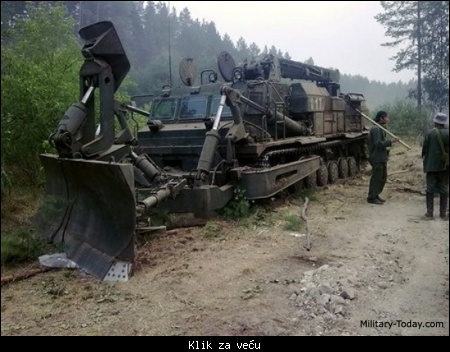
The BAT-2 is fitted with a large bulldozer blade, which is larger than on the previous BAT-M. The blade width is adjustable to suit the task. In bulldozer mode the blade is 4.5 m wide, for road or track clearing it is 4.2 m wide, for grading operations it has a variable width between 4.1 and 4.35 m. The blade can also follow terrain contours. The BAT-2 drives graded track across terrain at a speed up to 6.8 km/h, across snow at 8.15 km/h, terrain with trees at 2.3 km/h. Vehicle has an earth working capacity of 200 - 250 m³/h when digging ditches.
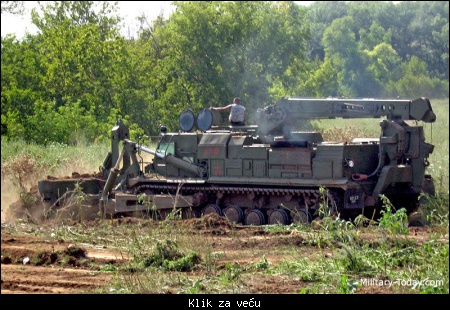
Vehicle also has a 2 t capacity crane at the rear of the cab. The crane has a maximum boom reach of 7.3 m and can be used to clear obstacles. This combat engineering vehicle is also fitted with a 25 t capacity winch with 100 m of cable.
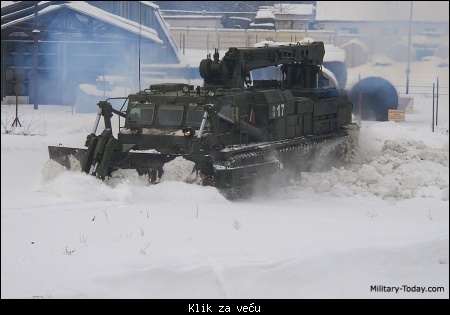
The BAT-2 is operated by a crew of two. Vehicle has a fully-enclosed forward control cab. The cab provides seating for the crew and for a combat engineer squad of eight men. The cab is fitted with NBC protection system. A variety of combat engineer stores are carried behind the cab.

This engineering vehicle is powered by a V-64-4 multi-fuel diesel engine, developing 700 hp. This engine is derived from that, used on the T-72 main battle tank. It is also used on some other Soviet military vehicles. Many automotive components are from the T-64 MBT. The BAT-2 fords water obstacles up to 1.3 m deep. This vehicle can operate in temperature range from -45°C to +45°C.

The BAT-2 carries no defensive armament.
Ali da se ne ispusti iz vida da je odelenje koje uz sebe prevozi naoružano sa svojim ličnim a tu je i bar jedan RPK.

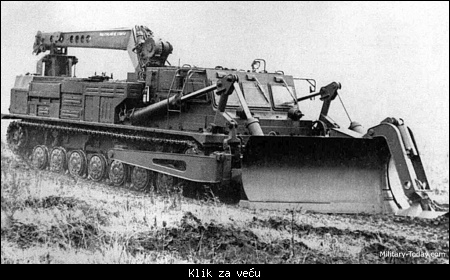
|
|
|
|
|
|
|
Poslao: 22 Jun 2019 21:08
|
offline
- A.R.Chafee.Jr.

- Legendarni građanin

- Pridružio: 27 Avg 2018
- Poruke: 10919
|
Citat:Za kupolicu i dodatno naoružanje se slažem samo nič ne vem dali bi vozač uz sve svoje rabote stizao i da puca ?
Treba da ima i drugara, strelca, koji bi pomagao u navigaciji. No trideset godina to spominju. Ima sa desne strane mesta za još jednog,otvori se rupa u krovu i stavi kupola.
|
|
|
|
|
|
|
|
|
Poslao: 22 Jun 2019 23:34
|
offline
- voja64

- Stručni saradnik foruma

- Pridružio: 10 Okt 2012
- Poruke: 25481
|
Posle Španca jedan čudni Brit
CET
Combat engineering vehicle

The FV180 CET is a versatile amphibious combat engineer vehicle
Entered service 1975
Crew 2 men
Dimensions and weight
Weight 17.7 t
Length 7.3 m
Width 2.76 m
Height 3.41 m
Armament
Machine guns 1 x 7.62 mm
Mobility
Engine Rolls-Royce C6TFR diesel
Engine power 320 hp
Maximum road speed 56 km/h
Amphibious speed on water 8 km/h
Range 320 km
Maneuverability
Gradient 60%
Side slope 30%
Vertical step 0.6 m
Trench 2 m
Fording 1.63 m
Fording (with preparation) Amphibious
The FV180 Combat Engineer Tractor (CET) is currently in service with the Royal Engineers. It is a specialist armored vehicle of the British Army. Whereas most such vehicles are converted tanks, the CET was purpose-designed for the engineering role from the start. In 1974 seven prototypes of this engineering vehicle were built. After extensive trials and some modifications this vehicle was accepted to service with the British Army in 1975. Production commenced in the Royal Ordnance factory in 1977. First production vehicles were delivered to the Royal Engineers in 1978. Export operators are India (39) and Singapore (1 . .

The CET is a versatile amphibious combat engineer vehicle. It's primary task is earth mowing, however it can assist in a variety of other battlefield engineering tasks. It can clear obstacles, repair roads, dig pits, prepare barriers, prepare riverbanks for vehicle crossing and recover other damaged, swamped or stuck armored vehicles.
A large earthmoving bucket is fitted at the rear of the vehicle. It is used for earth moving, clearing obstacles, paths, or digging pits for armored vehicles. It can lift loads up to 4 tonnes.
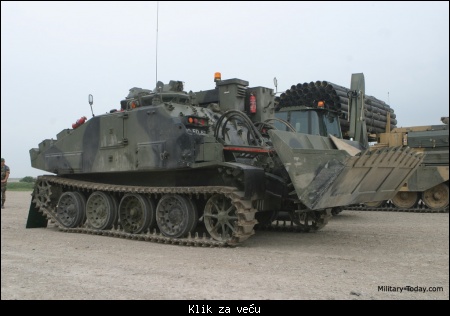
The FV180 has a twin-skin aluminum alloy armor hull. It provides protection against small arms fire and artillery shell splinters. It also has an NBC protection system.
This military vehicle is armed with a single 7.62-mm machine gun for self-defense.

The FV180 has a crew of two, including driver and engineer. Occupants sit in tandem position on the left side of the vehicle. The driver sits at the front and operates the winch, while the second crew member to his rear operates the bucket. Both crew members can reverse their seats to carry out each other's duties.

Vehicle is powered by 12.2-liter Rolls-Royce C6TFR turbocharged diesel engine, developing 320 hp. It seems that later production vehicles were fitted with a more fuel efficient engine. Vehicle uses a number of standard commercial automotive components. The engine and transmission are mounted at the right side of the hull. The FV180 can be driven equally fast forwards or backwards, enabling it quickly excavate, carry and conceal the soil.
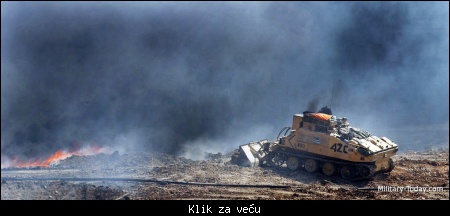
The CET has amphibious capability. With little preparation this combat engineering vehicle is fully amphibious. On water it is propelled by two waterjets. When not in use the waterjets are closed with armored covers to prevent damage. To help CET leave the water on steep slopes and riverbanks it is equipped with a 100 m winch cable attached to an anchor that can be fired by rocket, so the CET can winch itself ashore.
The FV180 Combat Engineering Tractor is due to be replaced with the new Terrier. It is a more capable and better protected engineering vehicle. Development of the Terrier is complete. From 2013 it will gradually replace the ageing fleet of the CETs in service with the Royal Engineers.
Još se baškarimo po Britaniji ..
|
|
|
|
|
|
|
Poslao: 22 Jun 2019 23:42
|
offline
- voja64

- Stručni saradnik foruma

- Pridružio: 10 Okt 2012
- Poruke: 25481
|
Trojan
Combat engineering vehicle

Primary mission of the Trojan combat engineering vehicle is to clear pathways through minefields
Entered service 2007
Crew 3 men
Dimensions and weight
Weight 62.5 t
Length 8.3 m
Width 3.5 m
Height 2.5 m
Armament
Machine guns 1 x 7.62 mm
Mobility
Engine Perkins CV12 diesel
Engine power 1 200 hp
Maximum road speed 59 km/h
Range 450 km
Maneuverability
Gradient 60%
Side slope 30%
Vertical step ~ 0.9 m
Trench ~ 2.3 m
Fording ~ 1 m
The Trojan AVRE (Armored Vehicle Royal Engineers) was developed by BAE Systems to meet a requirement of the UK MoD. Development contract was awarded in 2001. First prototype was delivered to Royal Engineers for trials and evaluation in 2004. Deliveries commenced in 2006. The Trojans were first operationally used in Afghanistan in 2009. British Army is the only operator of this combat engineering vehicle. Primary mission of the Trojan is to clear pathways through minefields, creating safe lanes for other vehicles. It allows assault units to move rapidly through minefields, before enemy forces establish defenses. It is also used for many other engineering tasks. A total of 33 Trojans were built for the British Army.

The Trojan is based on a modified Challenger 2 main battle tank chassis. The turret has been removed and replaced by a new superstructure with special equipment. The Trojan is fitted with mine plough, dozer blade and a large excavator arm. It replaced the obsolete Chieftain-based AVRE in service with the Royal Engineers.

The Trojan is fitted with a full-length mine plough, that pushes mines out of the way to clear a safe path for following vehicles. A clear lane marking system can also be fitted. The mine plough can be easily replaced with a dozer blade.

The excavator arm is used for earth works, grabbing and moving obstacles, placing fascines. The standard bucket has a 1 m³ capacity. Bucket can be replaced with other attachments. The arm lift capacity is 6.5 tonnes.
This vehicle can carry fascines and drop into ditches. Also it can tow a trailer carrying Python rocket-propelled minefield breaching system.

The Trojan combat engineering vehicle has the same level of armor protection as the Challenger 2 MBT. It provides a very high level of protection against direct fire weapons. If required additional armor can be added. Vehicle also has enhanced protection against landmines. There is an NBC protection system for the crew, so this engineering vehicle can operate in hazardous environments.

This combat engineering vehicle is armed with a remotely controlled 7.62 mm machine gun for self-defense.
The Trojan has a crew of three, including commander, driver, and operator.
This combat engineering vehicle is powered by a Perkins CV12 TCA turbocharged diesel engine, developing 1 200 hp. Vehicle is also fitted with auxiliary power unit, which powers all systems, when the Trojan is stationary and the main engine is turned off.
Another new British armored engineering vehicle, designed in-line with the Trojan is the Titan armored brigdelayer.
|
|
|
|
|
|
|
Poslao: 22 Jun 2019 23:52
|
offline
- voja64

- Stručni saradnik foruma

- Pridružio: 10 Okt 2012
- Poruke: 25481
|
Za večeras da završimo na ostrvu i jedan Terrier

The Terrier is a general support combat engineering vehicle, intended for battlefield preparation
Entered service 2013
Crew 2 men
Dimensions and weight
Weight ~ 30 t
Length 6 m
Width 2.5 m
Height 2 m
Armament
Machine guns 1 x 7.62 mm
Mobility
Engine Caterpillar C18 diesel
Engine power 700 hp
Maximum road speed 70 km/h
Range ~ 600 km
Maneuverability
Gradient 60%
Side slope 40%
Vertical step ~ 0.6 m
Trench ~ 2 m
Fording ~ 1 m
The Terrier combat engineering vehicle was developed by BAE Systems to meet a requirement of the UK MoD. Development contract was awarded in 2002. The Terrier is a replacement for the current FV180 Combat Engineer Tractor, which entered service with the British Army back in 1976. A prototype of the Terrier was revealed in 2005. From 2013 it will replace the FV180 CET in service with the Royal Engineers. The British Army requirement is for 60 of these engineering vehicles. This machine is referred as the most advanced engineering vehicle of the British Army.

The Terrier is a general support engineering vehicle, intended for battlefield preparation in the indirect fire zone. It's typical tasks are route clearance, digging of anti-tank ditches, digging defensive positions for troops or armored vehicles. It also has a mine clearing capability. For these missions this combat engineering vehicle is fitted with a front high-capacity bucket. It is used to clear obstacles, dig pits and grip large items. There is also a side mounted excavator arm, that can lift up to 3 tonnes at maximum reach.

It can also tow a trailer carrying fascines, trackway, or Python minefield breaching system. Vehicle can be also fitted with a mine plough.

The new vehicle has more effective armor and mine protection, than the current FV180 CET. Hull of the Terrier is welded from steel. Crew compartment is lined with spall liners. Vehicle provides protection against small arms fire and artillery shell splinters. If required additional armor can be added. Vehicle has a double floor, which provides protection against landmines.

The Terrier has a crew of two, including commander and driver. However this engineering vehicle can be operated by remote control from up to 1 km away in dangerous environments.
The only defensive armament carried by the Terrier is a roof-mounted 7.62 mm machine gun. However a remotely controlled weapon station can be mounted.

The Terrier is powered by Caterpillar C18 turbocharged diesel engine, developing 700 hp. The Terrier is faster and more mobile than the current FV180 CET. It is worth mentioning, that roadwheels of the Terrier are based on the CV90 technology. This combat engineering vehicle is capable of keeping pace with the Challenger 2 main battle tanks and Warrior infantry fighting vehicles. The Terrier can be airlifted by the Boeing C-17 Globemaster III or Airbus A400M military transport aircraft.



http://www.military-today.com/engineering/terrier.htm
|
|
|
|
|
|
|
|
|
Poslao: 14 Nov 2019 17:37
|
offline
- voja64

- Stručni saradnik foruma

- Pridružio: 10 Okt 2012
- Poruke: 25481
|
Машина инженерной разведки ИРМ Жук (IRM Zhuk engineer reconnaissance vehicle)

Još jedna interesantna slika sa izložbe
Engineer reconnaissance vehicle IRM (Инженерная разведывательная машина) in Military-historical Museum of Artillery, Engineer and Signal Corps in Saint-Petersburg, Russia.jpg

IRM"Zhuk" je inžinjerijsko izviđačko borbeno vozilo namenjeno za izviđanje na kopnu i na vodi razvijeno 1970e.g u konstrukcionom birou paralelno sa razvojem -unapređenjem sa BMP-1/BMP-2.Proizvodnja je započeta tek 1980e.g sa kombinovanjem baznih komponenti oba BVPa.Do 1986.g je izrađeno prvih 50 vozila kada se preuredio novi dizajn gde se na jednom paru potpornih točkova dodao još po jedan hidraulični amortizer na dodatnom potpornjaku koji se od tada uočava.Nigde se u literaturi ne nalazi dodatno označavanje u modelima pa se tako može smetnuti sa uma da su po tim razlikama uočljive serije pre 1986 i posle.Vremenom je većina starijih modela na bazi oklopnog tela od BMP-1 sa 6 pari potpornjaka zamenjena /nadograđena poput BMP-2 gde su svi sa sedam pari potpornjaka.Konstrukciono borbeni prostor je podeljen na četiri celine od kojih je jedna motorno transmisona i nalazi se od zada.Druga je za vozača i nalazi se napred levo.treća za manipulanta-rukovaoca sredstvima za izviđanje koja se modularno postavljaju ispred gusenica napred i po želji se mogu spuštati ili podizati 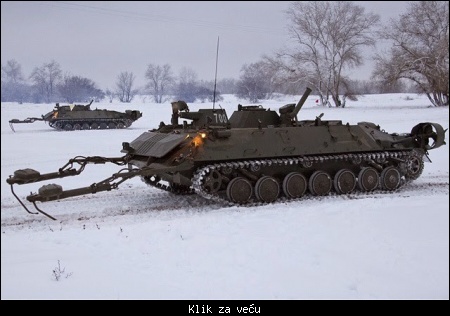

u zavisnosti dali je u radnom ili marševskom položaju

je napred i desno.
Četvrti centralni odeljak je predviđen za boravak do 4 vojnika-pionira/sapera .
Sva četiri odeljka su pod pritiskom radi sprečavanja ulaska vode kod plovidbe.
Za ulaz/izlaz ima tri poklopca na gornjoj zoni trupa i jedan sigurnosni za prinudni izlaz na dnu.Sam IRM je opremljen sa dva uvlačeća propelera u prstenastim navlakama koji služe kako za plivanje tako i za upravljanje u plovidbi.


Od inžinjerijske specijalne opreme u kompletu su tu dva minoistraživača P-147;po jedan periskop PIR-451; ТNPО-160, ТNP-370 и ТNV-25М periskopski uređaj za posmatranje poslužioca na P-147; Tu je i indikator horizonta AGI-1; Prenosni periskopski daljinomer DSP-30,Za orijentaciju nemere brez PAB-2M kod davanja podataka o osmotrenim objektima za navigaciju na vodi kao i većina oklonjača ima žiroskopski navigacijski uređaj TNA-3 kod podvodne vožnje koja se može izvoditi sa dopunskom opremom do dubine od 5m,Detektor dubine sa plovkom EIR i tri sonarna pretvarača kod izviđanja dna plovidbom iznad osmatrane lokacije vodene prepreke.Za rad dodatnog odelenja pionira/sapera u kompletu su i minositraživačRVM-2M i stari IMP-2 prenosni ručni.Za izviđanje geološkog sastava tla ima penetrometar PR-1 kao i bušilicu za uzimanje uzoraka zaleđenog tla na izviđanom pravcu.Na prednjem delu su dve upravljive ruke na kojima se montiraju minositraživači za detekciju metalnih i mina sa smanjenom magnetnom površinom koja se mogu naći ispred ovog inžinjerijskog vozila.Sklapanje i demontaža ruku se izvode za manje od tri minuta . Detektor mina potpuno zaustavlja vozilo isključivanjem pogona kada detektuje/naiđe na traženu prepreku u zahvatu kretanja.
Periskop PIR-451 je na raspolaganju komandiru i nalazi se sa desne strane jer je komandir ujedno i poslužilac ruku minskog detektora.Kod rada u ispresecanom terenu i šipražju teleskopski periskop se može produžiti do 1,5m ispred a vertikalno se kreće do 750mm dole goreIRM poseduje i uređaj za prečišćavanje vazduha kod kretanja po KONZu,automatski sistem za detekciju i gašenje požara na vozilu:
Pumpu za vodu kapaciteta 1,000 l/min.
Generator toplog dima za maskiranje vozila kod izviđanja prednjeg kraja pod borbom.
Težina 17,2 t u posadu se ubraja do 6 članova.
Dug 8,22 m , širina 3,15 m i visina 2,40 m. Klirens је 420 mm.
Maksimalna brzina na putu je do 52 km/h a u plovidbi do 12 km/h.
Za ličnu zaštitu u kompletu ima PKT postavljen u maloj kupolici za koju nosi 1,000 metaka.
Na zapadu je dugo postojalo verovanje da je IRM nastao na bazi haubice 2S1kada je u GDRu stigao prvi kontigent i saznalo sve TT mogućnosti IRM Zhuka.
PS.
Postoji ali ga ja još osim u literaturi nisam nafatao i IPR čije ime označava Inžinjerijski Podvodni Razveditelj i radi se o osavremenjenoj verziji IRM sa jasnom namenom za izviđanje podvodnih prepreka na većim dubinama za šta ima i adekvatnu opremu.Pobrojana je uz standardni snorkel do 5m i nastavak za izviđanje do većih dubina gde sam našao podatak da ide do 8m a negde se spominje i dubina u nagibu do 15m.Za ovo izviđanje se koriste i ona dva balasta /rezervoara komprimovanog vazduha na bokovima koji su i na standardnom IMR ali su većeg kapaciteta i dva manja dodatna u delu nosa.Od dotatne opreme ovaj IPR ima i komplet ronilačke opreme sa zatvorenim krugom za disanje.
Taj dorađeni IPR je delo kompanije -Локомотива "Муромтепловоз" i proizveden je u malom broju.
Ovaj prvi bi mogao da bidne taj IPR a drugi je klasični Zhuk na vodi u plovidbi..


Nadam se da je sada uz korištenje Zhuka svakom jasno kako se izviđa vodena prepreka o čemu sam u par navrata pisao na nekoliko tema ali nismo imali do sada ovako predstavljen i ovaj IRM.
|
|
|
|
|
|
|
|



























